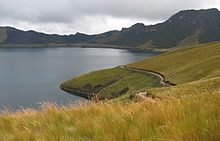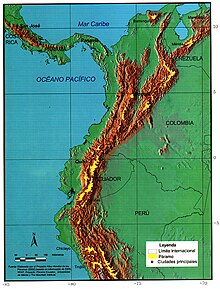Páramo (vegetation)

The Páramo (old Spanish: "bad, tree-free land") is a form of vegetation of the treeless, alpine highland steppes of tropical- equatorial mountains. The name comes from the Andes of South America, but is now also used for the similar vegetation of the Cordillera de Talamanca in Costa Rica and Panama , as well as for similar plant formations in the mountains of East Africa and New Guinea . The largest Páramo areas range from Colombia via Ecuador to northern Peru , where they occur above the tree line ( cloud forest ) between approx. 3500 and 4500 m in a humid climate. Similar heights apply to the entire tropical belt.
Characteristic elements are tall clusters of clusters and rosettes with an enormous number of leaves on thick, black humus with a pH value of 3.8 to 4.0. Plant growth takes place slowly but steadily and leads to the old age of the páramo plants. Agriculture is only possible in the form of pasture farming with llamas and alpacas in South America or sheep and goats in Africa.
In contrast to the Puna mountain steppe to the south (from around 15 ° south latitude) , the Páramo is not characterized by seasonal climatic fluctuations, but by daytime fluctuations: the temperatures fluctuate from around 8 ° C during the day to −3 ° C at night over the Quite constant throughout the year and are accompanied by a rapid change in weather. With an average of 1000 to 2000 mm annual precipitation and around 75% relative humidity as well as frequent fog , it is a humid, damp climate. In the highest areas of the Andes, the ground below 20 cm is permanently frozen .
differentiation
Some vegetation experts differentiate between the subpáramo, páramo and superpáramo.
Subpáramo
The Subpáramo forms the transition between montane forests and the Alpine Páramo. In the Subpáramo - the humid tropical Krummholzzone - up to 3 m high bushes thrive .
Páramo
Shrubs are receding or are only found in crippled forms. Ferns and perennial herbs come to the fore. However, larger-than-man-height plants from various families such as the sunflower (Asteraceae), the bellflower family (Campanulaceae) and the bromeliad family (Bromeliaceae) are also striking . The formative forms of life are crested trees and crested rosettes (e.g. Espeletia , "frailejones").
Superparamo
Almost exclusive vegetation by ground cover of different systematic affiliations marks the transition from the páramo to the frost rubble zone, but above all lichens and mosses. These ground cover plants have the ability to hold large amounts of water.
fauna
The animal world of the Páramo is relatively poor in species and decreases with increasing altitude. Among the mammals, the spectacled bear , the llamas , the opossum and the hare are known; The birds range from different species of hummingbird to the condor . Although the páramos are relatively cold, there are also a number of small frogs that develop directly in the egg without a larval stage freely swimming in the water, including species of the genera Bryophryne , Phrynopus , Noblella , Psychrophrynella and Lynchius .
use
The agricultural use of the Páramo stage is limited to potato cultivation and extensive long-distance grazing with cattle , which is very similar to the transhumance from the old world . Often the areas are cultivated intensively for a year before they are used as pasture for several years to recover the soil. The demand for dairy products is growing particularly in the vicinity of cities, so that high pasture farming (especially in Ecuador) has gained in importance.
Environmental significance
Since the vegetation of the Páramos can absorb and hold a great deal of water, it is an important natural water reservoir that feeds springs even during long dry periods. For this reason, the Páramo is placed under nature protection in many areas. The advance of agriculture and animal husbandry as well as the exploitation of raw materials (gold, coal, ores) threaten the drinking water supply of the nearby towns and cities, a situation that has recently led to more and more conflicts in all countries.
Web links
- Organización para la Educación y la Protección Ambiental
- Fundación Ecuatoriana de Estudios Ecológicos
- El Páramo, ecosistema de alta montaña
- paramo.be website of Wouter Buytaert
- Heck, Volker: Geoecological studies in the PNN Puracé / Colombia. An approach to optimize the recording of geo- and bio-resources in high Andean ecosystems
- Latin America News. Blind in at least one eye
Individual evidence
- ↑ a b c d Werner Rauh: Tropical High Mountain Plants: Growth and Life Forms , Springer, Berlin, Heidelberg, New York, London, Paris, Tokyo 1988, ISBN 978-3-540-17388-5 , pp. 18-21.
- ↑ Conradin Burga , Frank Klötzli and Georg Grabherr (eds.): Mountains of the earth - landscape, climate, flora. Ulmer, Stuttgart 2004, ISBN 3-8001-4165-5 . P. 35.
- ↑ Michael Richter (author), Wolf Dieter Blümel et. al (ed.): Vegetation zones of the earth. 1st edition, Klett-Perthes, Gotha and Stuttgart 2001, ISBN 3-623-00859-1 . P. 322.
- ↑ Axel Borsdorf u. Christoph Stadel: The Andes: A geographical portrait. Springer, Berlin / Heidelberg 2013, ISBN 978-3-8274-2457-0 . Pp. 276-277.




